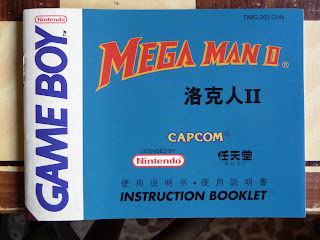Exploring Chinese Gameboy Games
A few months ago I bought Megaman II at a local store. It sports the serial DMG-203CHN and apparently is a legitimate copy for the asian markets, namely the People's Republic of China and Hong Kong (which of course wasn't part of the mainland back then).
The box and manual print quality are quite good, and so is the cartridge's plastic shell, thus I never suspected it to be a pirate copy. The Nintendo logo, their Official Seal of Quality, and all of Capcom's copyrights and trademarks are ostensibly displayed. These cartridges were manufactured by Mani Industries Limited and distributed by Mani (China) Limited, which apparently had offices in Hong Kong, Guangzhou and Shanghai.
I actually was already aware of Chinese Gameboy games, because I had stumbled years before into a Chinese cart of Ninja Spirit. Yes, the Irem arcade classic that had a bunch of home computer ports and is often thought to be a console exclusive for TG-16, was actually ported to Gameboy by Bits Studios. Bits incidentally is an UK developer which has been around since forever, and they apparently had a good relationship with Irem back then, since they were responsible for both the Gameboy R-Type ports and the late GBC compilation/reworking R-Type DX.
Anyway, I failed to secure a Ninja Spirit GB cart and soon forgot about the matter of Chinese Gameboy games altogether. The whole thing resurfaced a few days ago when I found out that the asian Megaman II's cover is featured in R20, the mammoth anniversary “complete works” book that came to the US as well courtesy of Udon Studios (it's on page 238 of the Japanese edition). However, doing a quick little search online, I've seen that there's little-to-none information about DMG-CHN cartridges. Probably they are taken for bootlegs all the time they show up on auction sites and that's it.
Securing a complete copy of Chinese Megaman II was a good thing, then. The box, manual and promotional mini-poster were quite informative and gave me a glimpse of what the asian (legit) Gameboy market looked like in the early nineties. In mid nineties Playstation collectors became soon aware that looking for a sought-after import title in the grey market would have meant to distinguish between the proper Japanese release and its Asian counterpart. Usually the only telling differences were the serial code and a fold-out paper sheet with basic controls and menu operations, written in English and/or Chinese. A few years later, from the PS2 era onward, we were all much more confident about import matters, and Asian releases began to be exploited to our own advantage: Asian's English friendly Demon's Souls being probably the most striking case, having started a phenomenon of mass-importing that eventually led to the game's worldwide release.
It's interesting to notice how the beginning of the Asian market didn't coincide with the Playstation era, and that once again Yokoi's grey little wonder was ahead of its times. According to the promotional leaflet, the following games were officially imported by Mani China Limited to PRC and Hong Kong: Nintendo's Super Mario Land, Super Mario Land 2, Dr. Mario, Tennis, Tetris, F1 Race and Yakuman; Capcom's Megaman II, Bionic Commando and Gargoyle's Quest; Sunsoft's Blaster Master Jr.; Banpresto's Peke to Poko no Daruman Busters; Taito's Elevator Action, Puzzle Bobble Chase HQ and Sagaia (according to GameFAQs: DMG-116CHN); Hudson's “Bomber Boy” (aka Dynablaster), PC Genjin (Bonk), Adventure Island 2 and Milon's Secret Castle; Irem's R-Type II, Ganso!! Yancha-Maru, Shisenshou, and Saigo no Namichi / Ninja Spirit. Two 4-in-1 cartridges are also advertised: one with the four aforementioned Taito games, and another with Nintendo's Tetris, Tennis, Yakuman and Alleyway.
But enough talk, let's have a look at the gallery. Enjoy!









It's a bit misleading to say Bits "has been around" - their site is under a different name, shows no sign of an update since 2006, and all their links redirect to the site itself. I think they're more dead than yesterday's bacon. I never heard of them after around the time they cancelled the Warlocked sequel - "Wizards!", I think - which is a real pity, as the gameplay videos suggested it was pretty far along (though late in the GBA cycle). Anyone want to try poking them?
ReplyDeleteOn the Wizards gameplay video on YouTube there is a guy who says he spent a year developing the game only to have marketing shut it down, which is unfortunate. Sounds like a story for here...
It is interesting to see that it says "Mega Man." I wonder what the characters translate as.
ReplyDeleteIt uses Rockman's translation
DeleteLooks like a half-phonetic-half-translation of Rockman. Reads "Luo Ke Ren" (luo has no meaning in itself, ke means "to overcome", ren means "man" or "human")
ReplyDeleteI've no clue on the policies of the site regarding emulation (I think they're OK with it provided it's obscure enough?), but if you're able to dump the ROM of this cartridge, it would be appreciated by the obscure & retro community at large.
ReplyDeleteYou'd be disappointed, really - The game inside is by all means indistinguishable from the USA version. It's interesting to notice that it isn't uncommon for an Asian game to be based on the western release, rather than the Japanese original.
ReplyDeleteBack in the 90's I bought a few used Asian Gameboy and Game Gear games at K-Mart of all places. (In the US) They were a mix of Chinese and Japanese games, including some that had a lot of Japanese text like a board-game/RPG based on the anime Ninku. I bought Sagaia from K-Mart and played it a ton.
ReplyDeletek-mart?? really
ReplyDeleteHi Gambler, can you get in touch with me at castlevania-64 atty hotmail dotty com? Got some questions on this version... cheers
ReplyDelete